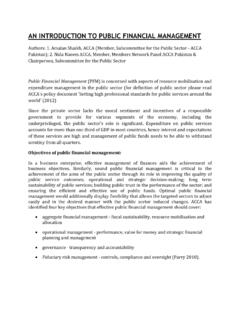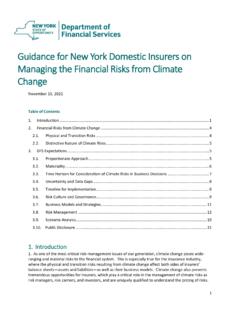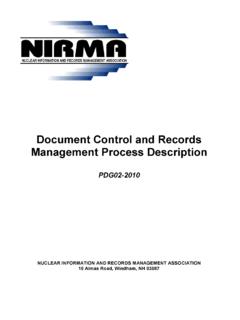Transcription of Infrastructure Financing Instruments and Incentives
1 Infrastructure Financing Instruments and Incentives 2015 Infrastructure Financing Instruments and Incentives Contact: Raffaele Della Croce, Financial Affairs Division, OECD Directorate for Financial and Enterprise Affairs [Tel: +33 1 45 24 14 11 | Joel Paula, Financial Affairs Division, OECD Directorate for Financial and Enterprise Affairs [Tel: +33 1 45 24 19 30 | or Mr. Andr Laboul, Deputy-Director, OECD Directorate for Financial and Enterprise Affairs [Tel: +33 1 45 24 91 27 | FOREWORD Infrastructure Financing Instruments AND Incentives OECD 2015 3 Foreword This taxonomy of Instruments and Incentives for Infrastructure Financing maps out the investment options available to private investors, and which Instruments and Incentives are available to attract private sector investment in Infrastructure .]]]
2 The coverage of Instruments is comprehensive in nature, spanning all forms of debt and equity and risk mitigation tools deployed by governments and agents. While the taxonomy is meant to capture all forms of private Infrastructure finance techniques, a focus of this work is to identify new and innovative Financing Instruments and risk mitigation techniques used to finance Infrastructure assets. Part I of this report provides the foundation for the identification of effective Financing approaches, Instruments , and vehicles that could broaden the Financing options available for Infrastructure projects and increase as well as diversify the investor base, potentially lowering the cost of funding and increasing the availability of Financing in Infrastructure sectors or regions where investment gaps might exist.
3 Part II identifies the range of Incentives and risk mitigation tools, both public and private, that can foster the mobilisation of Financing for Infrastructure , particularly those related to mitigating commercial risks. This report benefited from comments from the G20 Investment and Infrastructure Working Group, from the G20/OECD Task Force on Institutional Investors and long -term Financing , from the following OECD bodies: the Committee on Financial Markets, the Insurance and Private Pension Committee and the Working Party of Private Pensions, and from the following private sector institutions (amongst others unnamed): the long -term Investors Association and the Club of long -term Investors.
4 The report was submitted to the G20 IIWG meeting in Berlin on 20-21 August 2015, and then transmitted to the September 2015 meeting of the G20 Finance Ministers and Central Bank Governors. TABLE OF CONTENTS Infrastructure Financing Instruments AND Incentives OECD 2015 5 Table of contents Introduction .. 7 Background of the taxonomy .. 9 Objectives of the taxonomy .. 10 Part I. Financing Instruments and channels .. 13 Financial Instruments of the taxonomy .. 14 Financing Instruments - descriptions .. 20 References .. 39 Part II.
5 Risk mitigation and Incentives for Infrastructure finance .. 45 Risks in Infrastructure investment .. 46 Classification of risk in Infrastructure .. 47 Risk management environment .. 48 Risk management of Infrastructure asset cash flows .. 50 Risk mitigation Instruments and techniques for Infrastructure finance .. 50 Impact of Instruments on financial viability .. 53 Risk mitigation and Incentives descriptions of Instruments .. 53 Appendix Description of risk linked to Infrastructure assets .. 61 References .. 63 Annex A. Publications consulted for furthur reading.
6 67 INTRODUCTION Infrastructure Financing Instruments AND Incentives OECD 2015 7 Introduction1 Traditionally, Infrastructure investments have been financed with public funds. Governments were the main actor in this field, given the inherent public good nature of Infrastructure and the positive externalities often generated by such facilities. However, public deficits, increased public debt to GDP ratios and, at times, the inability of the public sector to deliver efficient investment spending, have in many economies led to a reduction in the level of public funds allocated to Infrastructure .
7 Budgetary pressures have been compounded in some cases by the need to repair bank balance sheets and rebuild capital and liquidity buffers, owing in part to strengthened prudential regulation in the banking sector. As a consequence, it is increasingly acknowledged that alternative sources of Financing are needed to support Infrastructure development. In this context, much attention is being focused on the institutional investor sector, given the long -term nature of the liabilities for many types of institutional investors and their corresponding need for suitable long -term assets.
8 For various reasons, including a lack of familiarity with Infrastructure investments, institutional investors at present allocate a very small fraction of their investments to Infrastructure assets. These investors have traditionally invested in Infrastructure through listed companies and fixed income Instruments . Infrastructure can be financed using different capital channels and involve different financial structures and Instruments . Some, like listed stocks and bonds, are market-based Instruments with well-established regulatory frameworks.
9 Banks have traditionally been providers of Infrastructure loans. Efforts are underway to develop new financial Instruments and techniques for Infrastructure finance2. These efforts appear to be having some success. Data indicate, for example, that developments in the equity market for investments in Infrastructure are promising and that the creation of a liquid market for project bonds can be a good complement to syndicated loans for project finance. Done properly, the securitisation of bank loans could help support lending and diversify risks, while also assisting in the development of transparent capital market Instruments .
10 Many investors nonetheless perceive a lack of appropriate Financing structures. Only the largest investors have the capacity to invest directly in Infrastructure projects. Smaller pension funds in particular require pooled investment vehicles. Collective investment vehicles have been available, such as Infrastructure funds, but problems with high fees, potential mismatches between asset life and fund vehicle, and extensive leverage mean 1 See Annex A. for a list of reports and OECD publications that were consulted for this project.



















